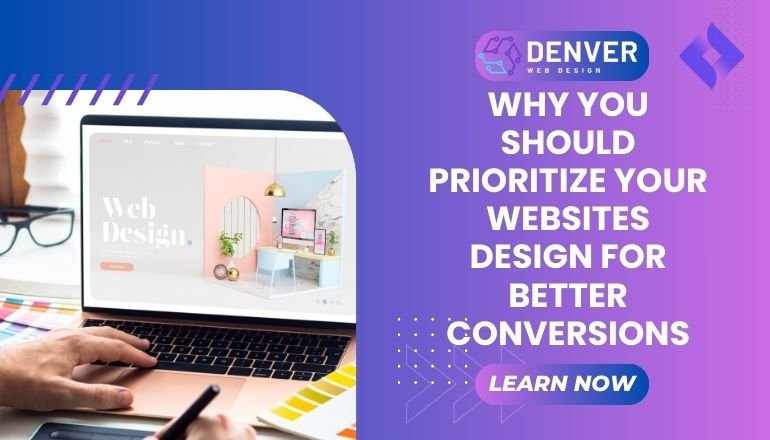
Introduction:
In the digital age, a well-designed website is crucial not only for attracting visitors but also for converting them into customers. Prioritizing web design isn’t just about aesthetics—it’s about building a seamless experience that encourages action. By following best practices in web design, including responsive design and focusing on conversion rate optimization (CRO), you can create a website that drives success. A professionally designed site ensures better user experiences, stronger SEO performance, and higher conversions. If you’re looking to boost your website’s results, Web Design Denver is here to help guide you through the process.
What is Conversion Rate Optimization (CRO) in Web Design?
Conversion Rate Optimization (CRO) refers to the process of improving the effectiveness of a website in turning visitors into customers or achieving specific business goals. In web design, it involves strategically designing your site’s layout, content, and elements to encourage actions—such as filling out forms, making purchases, or signing up for newsletters. Key components of a CRO-friendly web design include intuitive navigation, clear calls-to-action (CTAs), fast load times, and a responsive design. With mobile-first design and an easy-to-navigate interface, a well-optimized website can increase engagement and ultimately boost conversions.
Why is Web Design Essential for Your Website’s Conversions?
The design of your website is a direct reflection of your business, and a polished design can significantly impact both user experience (UX) and SEO for websites. Poor design can frustrate users and drive them away before they have the chance to convert, while a well-executed design can guide them smoothly toward your desired action. A responsive web design, for instance, ensures users on all devices have a seamless experience. By following SEO best practices and building an SEO-optimized website, your design can also improve your site’s ranking in search engines, making it easier for potential customers to find you.
Better design also increases user trust, which is critical for conversions. A professional, attractive website with clear, accessible information makes visitors feel more confident in your brand. Whether you’re running an e-commerce web design project or a service-based business site, optimizing design can turn browsing into actual purchases or leads.
Key Features/Components of Web Design for Better Conversions
A high-converting website design relies on several crucial components:
- Responsive Web Design: Adapt the design for various devices and screen sizes to ensure a consistent experience for desktop, tablet, and mobile users.
- Clear Calls-to-Action (CTAs): Place obvious CTAs on key pages to guide users through the conversion process, such as “Buy Now,” “Subscribe,” or “Get a Free Quote.”
- Easy Navigation: Simplify the user experience with intuitive menus and a clean layout that make it easy for users to find the information they need.
- Fast Page Load Speed: Visitors are likely to abandon your site if it takes too long to load, so optimizing the site’s speed is crucial for reducing bounce rates and improving conversion chances.
- Visual Hierarchy: Design elements like headings, images, and colors should help direct user attention to the most important parts of the site and the actions you want them to take.
- SEO-Optimized Design: Ensuring your website is not only functional but optimized for search engines increases its visibility, bringing in more potential customers to convert.
Best Practices for Web Design to Maximize Conversions
To ensure your website achieves high conversion rates, here are key best practices to follow:
- Prioritize User Experience (UX): Focus on easy navigation, site speed, and clear messaging. A user-friendly website keeps users engaged and reduces frustration.
- Embrace a Mobile-First Approach: With increasing mobile traffic, ensure that your website is optimized for mobile users first and foremost.
- Use a Clean and Simple Design: Avoid overcrowding the page with unnecessary details. Simplicity can often lead to better conversion because visitors can easily find the information or actions they’re looking for.
- Strategic Use of CTAs: Use contrasting colors, large buttons, and place CTAs above the fold for easy visibility. Ensure they’re aligned with the visitors’ intent.
- Integrate Social Proof: Customer reviews, testimonials, and case studies help build credibility and can nudge users toward converting.
- Optimize Forms: Simplify the user journey by reducing form fields and offering easy login options, such as through social media or single-click registrations.
Common Mistakes to Avoid in Web Design for Conversions
Although optimizing your website can boost conversions, it’s important to avoid common web design pitfalls:
- Poor Mobile Usability: Neglecting mobile-first design means losing out on the growing segment of mobile users.
- Overly Complex Design: A confusing or cluttered layout can overwhelm visitors and lead to high bounce rates. Simplicity is key for driving conversions.
- Slow Load Times: A delay of even a few seconds in page load time can result in lost sales. Compress images and optimize code to keep your site fast.
- Unclear CTAs: Vague or hard-to-find calls-to-action can frustrate users and diminish conversion rates. Ensure they are direct, clear, and easy to access.
- Lack of Trust Signals: A website without trust signals such as secure payment options, privacy policies, or customer testimonials can raise doubts and reduce conversions.
Conclusion: Key Takeaways
Prioritizing the design of your website is essential for enhancing conversions and fostering business growth. By focusing on elements like responsive web design, speed, easy navigation, and persuasive CTAs, you can increase the chances of turning visitors into loyal customers. A thoughtfully designed website not only helps create a seamless user experience but also improves SEO rankings, driving more traffic to your site. Whether you’re revamping your e-commerce web design or improving your custom web design, implementing conversion-focused design practices can lead to impressive results.
Take your web design to the next level today by partnering with Web Design Denver. Optimize your website for improved user experience, better SEO, and higher conversion rates.






